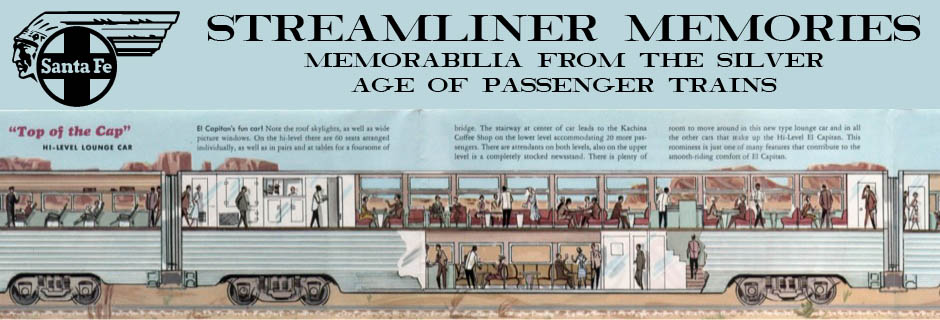While many of the locomotives on the postcards presented yesterday were replicas or were rebuilt to look like locomotives older than they really were, the remaining locomotives on B&O’s centenary postcards are authentic (although one was renumbered). Four of the locomotives were so large that the B&O depicted them on postcards that unfold to be twice as wide as an ordinary card.
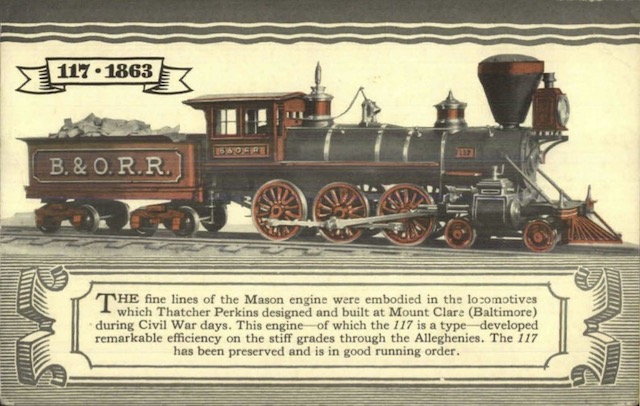 Click image to download a 166-KB PDF of this postcard.
Click image to download a 166-KB PDF of this postcard.
The text of this card mentions “the fine lines of the Mason locomotive,” but that refers to another locomotive, #25, that was built by Mason Machine Works and was also shown at the fair but not on a postcard. This locomotive was built by the B&O itself in 1863 and was originally numbered #147. The railroad renumbered it #117 for the Columbian Exposition, probably because that was the number of the first locomotive of its type.
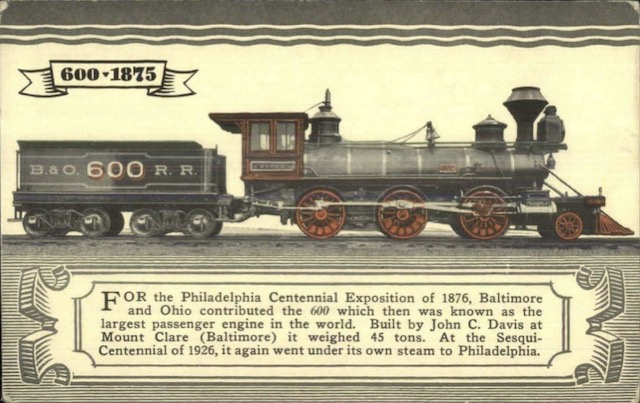 Click image to download a 168-KB PDF of this postcard.
Click image to download a 168-KB PDF of this postcard.
Built in 1875, #600 was at that time supposed to be the largest passenger locomotive in the world. B&O displayed it at the nation’s centennial expo in 1876.
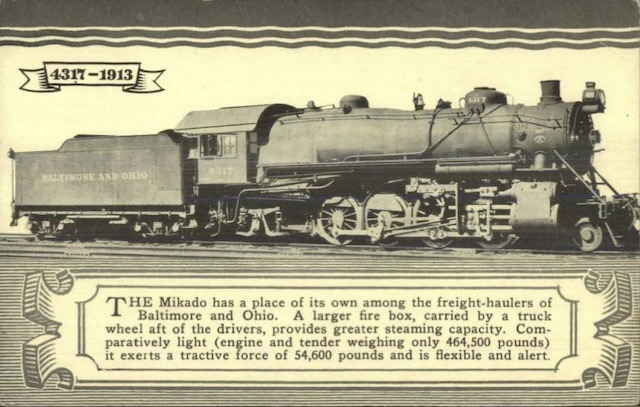 Click image to download a 169-KB PDF of this postcard.
Click image to download a 169-KB PDF of this postcard.
Entering the twentieth century, this postcard shows a 1913 2-8-2 locomotive. Baldwin delivered some 2-8-2 locomotives to Nippon Railway of Japan in 1897, leading people to call this locomotive class “Mikados.” It isn’t clear why the B&O chose to portray locomotive #4317 on this card as it was neither the first nor the most powerful Mikado used by the railroad.
 Click image to download a 85-KB PDF of this postcard.
Click image to download a 85-KB PDF of this postcard.
Delivered in 1917, this locomotive is known as a Mallet after Swiss engineer Anatole Mallet, who designed locomotives with two sets of drivers. One set swiveled separate from the other to go around corners. Classic Mallets also had compound cylinders, meaning one set used high-pressure steam, with the steam being recaptured and then used in the other cylinders as lower pressure. This locomotive doesn’t actually fit the definition: it was built as a compound Mallet for Seaboard Air Line but proved too big for its needs. In 1920, it sold it to the B&O, which simplified the cylinders so they all used the same steam pressure.
 Click image to download a 91-KB PDF of this postcard.
Click image to download a 91-KB PDF of this postcard.
The 2-10-2 type of locomotive was pioneered by the Santa Fe Railway and therefore is known as a Santa Fe. The B&O bought 31 locomotives of this type from Baldwin in 1914 and 125 more in 1923. This is the first of that second group. Locomotives like this replaced the Mallets because they were almost as powerful yet much simpler to maintain.
 Click image to download a 140-KB PDF of this postcard.
Click image to download a 140-KB PDF of this postcard.
The next step after locomotives like the Santa Fe was to replace the two-wheel lead truck with four wheels, enabling the locomotive to take corners at the higher speeds desired for passenger service. This 4-8-2 was built for passenger service over the Allegheny Mountains in 1925 and named Lord Baltimore. I’ve previously shown a similar postcard when I didn’t realize it was part of this series.
 Click image to download a 106-KB PDF of this postcard.
Click image to download a 106-KB PDF of this postcard.
The newest B&O locomotive displayed at the fair was, surprisingly, a 4-6-2 Pacific type, whose heritage goes back to 1901. Nowhere near as powerful as the Lord Baltimore, this president series was used to pull passenger trains between Washington and Jersey City.
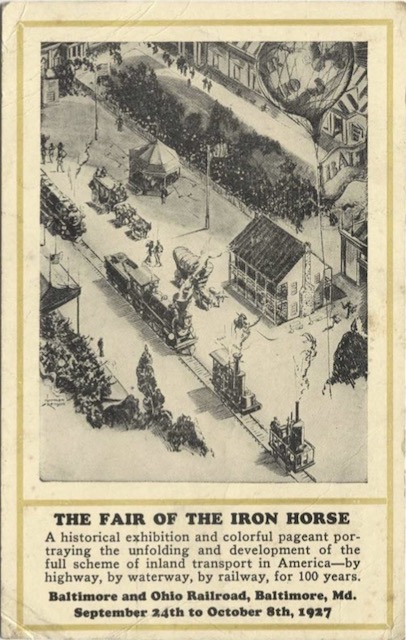 Click image to download a 225-KB PDF of this postcard.
Click image to download a 225-KB PDF of this postcard.
The fifteenth postcard in the series simply advertised the fair. It appears to show the York, the Thomas Jefferson, the Memnon, and the Mikado. The drawing is signed Norman Kenyon, a New York artist who lived to be 100 years old. Born in Massachusetts in 1901, Kenyon did illustrations for magazines such as Colliers, advertisements for companies such as Chrysler, and was particularly known for his maritime paintings.
